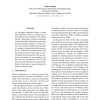NAACL
2007
13 years 10 months ago
2007
We compare two pivot strategies for phrase-based statistical machine translation (SMT), namely phrase translation and sentence translation. The phrase translation strategy means t...
NAACL
2007
13 years 10 months ago
2007
An intelligent thesaurus assists a writer with alternative choices of words and orders them by their suitability in the writing context. In this paper we focus on methods for auto...
NAACL
2007
13 years 10 months ago
2007
This work evaluates a system that uses interpolated predictions of reading difficulty that are based on both vocabulary and grammatical features. The combined approach is compared...
NAACL
2007
13 years 10 months ago
2007
We present a sentence compression system based on synchronous context-free grammars (SCFG), following the successful noisy-channel approach of (Knight and Marcu, 2000). We define...
NAACL
2007
13 years 10 months ago
2007
NAACL
2007
13 years 10 months ago
2007
This article describes a machine translation system based on an automatic post-editing strategy: initially translate the input text into the target-language using a rule-based MT ...
NAACL
2007
13 years 10 months ago
2007
We propose a new framework for supervised machine learning. Our goal is to learn from smaller amounts of supervised training data, by collecting a richer kind of training data: an...
NAACL
2007
13 years 10 months ago
2007
Letter-to-phoneme conversion generally requires aligned training data of letters and phonemes. Typically, the alignments are limited to one-to-one alignments. We present a novel t...
NAACL
2007
13 years 10 months ago
2007
We relate the problem of finding the best application of a Synchronous ContextFree Grammar (SCFG) rule during parsing to a Markov Random Field. This representation allows us to u...
NAACL
2007
13 years 10 months ago
2007
We present several improvements to unlexicalized parsing with hierarchically state-split PCFGs. First, we present a novel coarse-to-fine method in which a grammar’s own hierarc...








